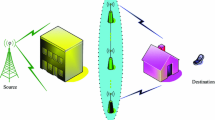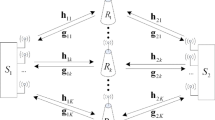Abstract
This paper presents joint power allocation and interference mitigation techniques for the downlink of spread spectrum systems which employ multiple relays and the amplify and forward cooperation strategy. We propose a joint constrained optimization framework that considers the allocation of power levels across the relays subject to an individual power constraint and the design of linear receivers for interference suppression. We derive constrained minimum mean-squared error (MMSE) expressions for the parameter vectors that determine the optimal power levels across the relays and the linear receivers. In order to solve the proposed optimization problem efficiently, we develop joint adaptive power allocation and interference suppression algorithms that can be implemented in a distributed fashion. The proposed stochastic gradient (SG) and recursive least squares (RLS) algorithms mitigate the interference by adjusting the power levels across the relays and estimating the parameters of the linear receiver. SG and RLS channel estimation algorithms are also derived to determine the coefficients of the channels across the base station, the relays and the destination terminal. The results of simulations show that the proposed techniques obtain significant gains in performance and capacity over non-cooperative systems and cooperative schemes with equal power allocation.







Similar content being viewed by others
References
Sendonaris A, Erkip E, Aazhang B (2003) User cooperation diversity—parts I and II. IEEE Trans Commun 51(11):1927–1948
Laneman JN, Wornell GW (2003) Distributed space-time-coded protocols for exploiting cooperative diversity in wireless networks. IEEE Trans Inf Theory 49(10):2415–2425
Laneman JN, Wornell GW (2004) Cooperative diversity in wireless networks: efficient protocols and outage behaviour. IEEE Trans Inf Theory 50(12):3062–3080
Huang WJ, Hong YW, Kuo CCJ (2007) Decode-and-forward cooperative relay with multi-user detection in uplink CDMA networks. In: Proc. IEEE global telecommunications conference, pp 4397–4401
Kramer G, Gastpar M, Gupta P (2005) Cooperative strategies and capacity theorems for relay networks. IEEE Trans Inf Theory 51(9):3037–3063
Luo J, Blum RS, Cimini LJ, Greenstein LJ, Haimovich AM (2007) Decode-and-forward cooperative diversity with power allocation in wireless networks. IEEE Trans Wirel Commun 6(3):793–799
Long L, Hossain E (2008) Cross-layer optimization frameworks for multihop wireless networks using cooperative diversity. IEEE Trans Wirel Commun 7(7):2592–2602
Venturino L, Wang X, Lops M (2006) Multiuser detection for cooperative networks and performance analysis. IEEE Trans Signal Process 54(9):3315–3329
Vardhe K, Reynolds D, Valenti MC (1940) The performance of multi-user cooperative diversity in an asynchronous CDMA uplink. IEEE Trans Wirel Commun (Part 2) 7(5):1930–1940
Souryal MR, Vojcic BR, Pickholtz L (2006) Adaptive modulation in ad hoc DS/CDMA packet radio networks. IEEE Trans Commun 54(4):714–725
Comaniciu C, Poor HV (2006) On the capacity of mobile ad hoc networks with delay constraints. IEEE Trans Wirel Commun 5(8):2061–2071
Levorato M, Tomasin S, Zorzi M (2008) Cooperative spatial multiplexing for ad hoc networks with hybrid ARQ: system design and performance analysis. IEEE Trans Commun 56(9):1545–1555
Fischione C, Johansson KH, Sangiovanni-Vincentelli A, Zurita Ares B (2009) Minimum energy coding in CDMA wireless sensor networks. IEEE Trans Wirel Commun 8(2):985–994
Kastrinogiannis T, Karyotis V, Papavassiliou S (2008) An opportunistic combined power and rate allocation approach in CDMA ad hoc networks. In: 2008 IEEE Sarnoff symposium, 28–30 April 2008, pp 1–5
Liu C-H (2007) Energy-optimized low-complexity control of power and rate in clustered CDMA sensor networks with multirate constraints. In: Proc. IEEE 66th vehicular technology conference, 30 September–3 October 2007, pp 331–335
Min C, Oh C, Yener A (2006) Efficient scheduling for delay constrained CDMA wireless sensor networks. In: Proc. IEEE 64th vehicular technology conference, VTC-2006 Fall. 2006, 25–28 September 2006, pp 1–5
de Lamare RC (2009) Joint power allocation and interference mitigation techniques for cooperative spread spectrum systems with multiple relays. In: Proc. IEEE international symposium on wireless communications systems
Verdu S (1998) Multiuser detection. Cambridge
de Lamare RC, Sampaio-Neto R (2007) Adaptive interference suppression for DS-CDMA systems based on interpolated FIR filters with adaptive interpolators in multipath channels. IEEE Trans Veh Technol 56(6):2457–2474
de Lamare RC, Sampaio-Neto R (2008) Minimum mean squared error iterative successive parallel arbitrated decision feedback detectors for DS-CDMA systems. IEEE Trans Commun 56(5):778–789
de Lamare RC, Sampaio-Neto R (2003) Adaptive MBER decision feedback multiuser receivers in frequency selective fading channels. IEEE Commun Lett 7(2):73–75
de Lamare RC, Sampaio-Neto R (2005) Reduced-rank interference suppression for DS-CDMA based on interpolated FIR filters. IEEE Commun Lett 9(3):213–215
de Lamare RC, Sampaio-Neto R, Hjørungnes A (2007) Joint iterative interference cancellation and parameter estimation for CDMA systems. IEEE Commun Lett 11(12):916–918
de Lamare RC, Sampaio-Neto R (2005) Adaptive reduced-rank MMSE filtering with interpolated FIR filters and adaptive interpolators. IEEE Signal Process Lett 12(3):177–180
de Lamare RC, Sampaio-Neto R (2007) Reduced-rank adaptive filtering based on joint iterative optimization of adaptive filters. IEEE Signal Process Lett 14(12):980–983
de Lamare RC, Sampaio-Neto R (2009) Adaptive reducedrank processing based on joint and iterative interpolation, decimation and filtering. IEEE Trans Signal Process 57(7):2503–2514
de Lamare RC, Diniz PSR (2009) Set-membership adaptive algorithms based on time-varying error bounds for CDMA interference suppression. IEEE Trans Veh Technol 58(2):644–654
Haykin S (2002) Adaptive filter theory, 4th edn. Prentice- Hall, Englewood Cliffs
Csiszár I, Tusnády G (1984) Information geometry and alternating minimization procedures. Stat Dec (l):205–237. Supplement issue
Niesen U, Shah D, Wornell GW (2009) Adaptive alternating minimization algorithms. IEEE Trans Inf Theory 55(3):1423–1429
Gersho A, Gray RM (1992) Vector quantization and signal compression, Kluwer/Academic Press/Springer
de Lamare RC, Alcaim A (2005) Strategies to improve the performance of very low bit rate speech coders and application to a 1.2 kb/s codec. In: IEE proceedings—vision, image and signal processing, vol 152, no 1
Rappaport TS (1996) Wireless communications. Prentice-Hall, Englewood Cliffs
Author information
Authors and Affiliations
Corresponding author
Additional information
The work of R. C. de Lamare was supported by the University of York, York Y010 5DD, UK.
Rights and permissions
About this article
Cite this article
de Lamare, R.C. Joint Power Allocation and Interference Mitigation Techniques for Cooperative Spread Spectrum Systems with Multiple Relays. Mobile Netw Appl 16, 629–639 (2011). https://doi.org/10.1007/s11036-010-0291-1
Published:
Issue Date:
DOI: https://doi.org/10.1007/s11036-010-0291-1




